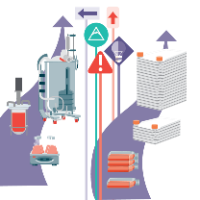Beginning with the end in mind: how early plasmid design and CDMO partnership can set you up for success in cell or gene therapy manufacturing
Cell & Gene Therapy Insights 2022; 8(8), 945–951
DOI: 10.18609/cgti.2022.140
Roisin McGuigan, Editor, BioInsights talks to OXGENE’s Richard Parker-Manuel, PhD,Group leader for plasma engineering & production &, Qian Liu, PhD, Head of engineering & production
Plasmids are important tools for building gene therapies, but substantial challenges exist for manufacturing a plasmid-based therapy – making it crucial for innovators to be aware of best practises. We spoke to Dr Richard Parker-Manuel and Dr Qian Liu about how careful plasmid design through promoter/capsid discovery and plasmid engineering early on in therapeutic development can help ensure that an innovator begins their journey with the right tools – and how an early CDMO partnership can foster success later down the line.
Could you both tell me a bit about your backgrounds, and your current work?
RP: My background is in DNA replication, recombination, and repair. For my PhD in Bath, I researched DNA replication in archaea before moving to York to do a post-doctorate working on mini-chromosome maintenance protein (MCM), the human replicative DNA helicase complex. I first joined OXGENE in 2012. I currently run the plasmid engineering and production group, in which we make constructs and libraries for a variety of commercial and R&D projects. The work we are currently doing includes assembling libraries for promoter and capsid screening platforms, improving our transient lentiviral packaging plasmid system, and assembling constructs for customers who wish to evaluate our TESSA™ adeno-associated virus (AAV) manufacturing technology. We are also setting up a manufacturing facility for research grade AAV and lentiviral plasmids.
QL: I did my PhD in molecular nutrition, focusing on molecular and cell biology and investigating the molecular mechanism of adipose tissue differentiation. After that, I completed two postdoctoral projects focusing on human embryonic stem cell differentiation mechanisms and bioartificial liver development. I joined OXGENE in 2017, initially as a cell line engineering scientist. I then gradually started managing various functions within the company, including in cell sciences and biomanufacturing. Now, I head the department of engineering and production. Our department is responsible for the engineering and production of plasmids, viral vectors, and cell lines, aiming to provide high-quality starting materials for cell and gene therapy manufacturing.
In your own experience, what are the common pitfalls that therapy developers face when selecting the right plasmids for their application? What repercussions can making the wrong choice early on have later in development?
QL: From our interactions with customers in the past, we sometimes see that people fail to consider all aspects when they are selecting a plasmid. It can be easy to miss things like regulatory compliance and intellectual property (IP) checks.
One example is some customers we had using special AAV vectors. They did not complete the IP checks in the early phase of the project and had to do so later on. It luckily did not result in any consequences in that case, but we might not be this lucky every time. If the IP side is not checked in the beginning, it might catch up with you in a later phase.
In terms of regulatory compliance, we also heard about a therapeutic company who did AAV production using a helper plasmid containing adenovirus late genes, which we believe are not recommended by the FDA. The company found this in the later stage of their product development process, which meant they would need to source a different helper plasmid and restart the program from early phase, or to do more work to justify their use of the helper plasmid containing the adenovirus late genes. These kinds of issues consume both extra cost and time.
RP: It all depends on the chosen vector system, because AAV vectors have different properties from lentiviral vectors. AAV issues could include choosing the wrong capsid for the target tissue, having a genome that is too large to fit in the capsid, or getting a high proportion of empty capsids, which is something that our modified Rep-Cap plasmid can help to avoid. One of the biggest challenges facing AAV gene therapy at the moment is the human immune system – i.e. pre-existing immunity to the viral capsid. One way to solve this could be by engineering the capsid proteins to avoid recognition by neutralizing antibodies. With lentiviral vectors, there is no structural capsid, so packaging size is slightly less of a constraint – although large genes can impact titers. Other transgene properties such as the presence of transcription termination signals can also cause low yields without careful optimization. It is important to design vectors with safety in mind from the outset, to avoid having to reconfigure them later. For instance, the woodchuck hepatitis virus post-transcriptional regulatory element (WPRE) in lentiviral vectors is often used, but the unmodified wild-type version can potentially cause tumorigenesis.
What are the important aspects developers should consider when selecting plasmids for their application, and what is your advice to developers looking to choose the right tools?
RP: The first consideration is which vector system to use. The plasmids are simply instructions for producing viral vectors, so it is important to have a clear idea about vector design early on. For AAV, this includes considerations such as which capsid to use, the transgene structure, and whether to choose a single-stranded or self-complementary genome. The plasmids can then be tailored accordingly. Questions to ask include: have the vectors been designed with safety in mind? And does the developer have the freedom to operate with all the elements of the proposed vector design? In terms of productivity and potency, our modified Rep-Cap plasmid gives higher yields of full capsid AAV compared with the conventional configuration.
How early in therapeutic development should plasmid design and engineering be considered?
RP: Plasmid design and engineering should be considered as early as possible, during the discovery or pilot testing phases once the transgene has been chosen. Then, other elements such as promoter, polyadenylation signal, and plasmid backbones can be optimized. This way, early efficacy studies can use a vector that is as close to the final configuration as possible. Switching to a different design later could mean revalidating the new design, which could be costly and cause delays.
How can plasmid design help to address some of the current key challenges in cell and gene therapy development?
RP: The design of the genome plasmid can affect, not only yield, but also the quality of the viral vector that can be produced. For example, removing extraneous sequences from within a viral genome or adding stuffer DNA to the backbone could help improve the full/empty ratio of an AAV product.
The design of the trans-packaging plasmids is also important. For example, we found our lentiviral packaging plasmids outperformed those of competitors in head-to-head studies.
QL: From the safety side, we need to eliminate or modify potentially toxic genes or genes that could cause safety concerns, like wild-type WPRE sequences in lentiviral vectors or adenovirus late genes in helper plasmids for AAV production. This should be considered in the plasmid design phase. Another safety-related issue is replication competent virus generation, which is always something regulatory authorities pay attention to. In our plasmid design we try to reduce the homology of different viral packaging elements, and also try to separate different elements into different plasmids. This reduces the chance of homologous recombination, thus reducing the likelihood of generating replication competent viruses.
What are the benefits of working with a partner organization for discovery work, and are there particular benefits to partnering with a single CDMO across the whole therapeutic pipeline?
QL: Reaching out to a contract development manufacturing organization (CDMO) for discovery work sounds a bit unusual – normally you might go to a contract research organization (CRO) to provide this kind of expertise. However, working with a CDMO that also has the capability and experience of doing discovery work, like OXGENE and WuXi Advanced Therapies, definitely provides an advantage. We can quickly figure out good approaches to achieve the clients’ goals, and provide powerful platforms for designing and screening to make the process more efficient. For example, we have bioinformatics tools already in place, and high-throughput or automated platforms for screening purposes.
In addition, CDMOs can have extra advantages compared to CROs; particularly in process development and manufacturing capabilities. For example, when designing a discovery strategy, we will naturally consider the needs of subsequent stages, such as designing the products in an easier way for process development, scaling up, and manufacturing, whilst also considering regulatory compliance. This will reduce the risk of having to modify the design pathways throughout the journey. In other words, doing discovery work with experienced CDMOs can help you to see the bigger picture, as they will consider the whole journey for the customer. The product development lifecycle has many stages: discovery, research, development, manufacturing, and regulatory submissions. In all these stages, therapeutic companies need different services. If they had to go to different organizations to receive each service, they would have to communicate with many organizations. The time cost of communication can be huge. The end-to-end platform provided by WuXi Advanced Therapies reduces the time and cost that a customer needs to spend on communication. It provides a more streamlined platform, that makes the development of the product from beginning to end much easier for the customer.
Affiliations
Richard Parker-Manuel, PhD
Group Leader for Plasmid Engineering & Production,
OXGENE
Qian Liu, PhD
Head of Engineering & Production,
OXGENE
Authorship & Conflict of Interest
Contributions: All named authors take responsibility for the integrity of the work as a whole, and have given their approval for this version to be published.
Acknowledgements: None.
Disclosure and potential conflicts of interest: The authors have no conflicts of interest.
Funding declaration: The authors received no financial support for the research, authorship and/or publication of this article.
Article & copyright information
Copyright: Published by Cell and Gene Therapy Insights under Creative Commons License Deed CC BY NC ND 4.0 which allows anyone to copy, distribute, and transmit the article provided it is properly attributed in the manner specified below. No commercial use without permission.
Attribution: Copyright © 2022 OXGENE. Published by Cell and Gene Therapy Insights under Creative Commons License Deed CC BY NC ND 4.0.
Article source: Invited; externally peer reviewed.
Submitted for peer review: Jul 19 2022; Revised manuscript received: Aug 12 2022; Publication date: Sep 14 2022.



